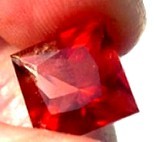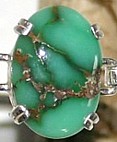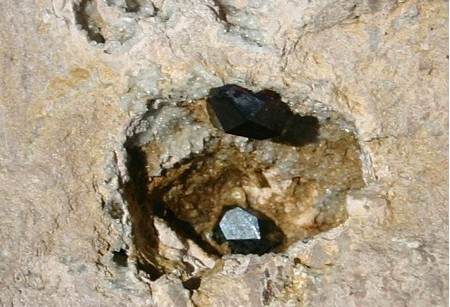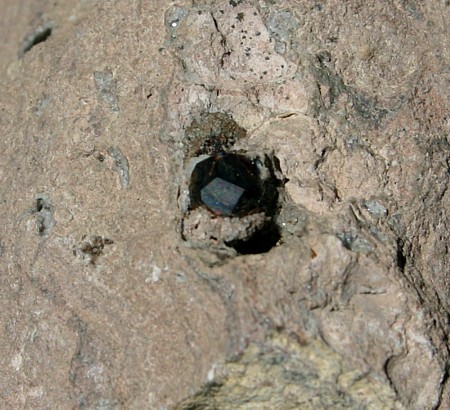
Garnet Hill Recreation Area, Ely, Nevada

 |
Garnet Hill Recreation Area, Ely, Nevada |
 |
Garnet Hill is a well known location for its fine garnet mineral specimens. The directions here tell you all you need to know to hunt there......
|
The Garnet Hill rock hound recreation area in White Pine County is located about 4 miles Northwest of Central Ely in the Eagan mountain range. The major access road to this area joins US Highway 50 about 6.4 miles West of the traffic signal at US 395 and US 50 junction in Ely. The area is locally referred to as Garnet Hill and this nationally known rock hounding area is famous for its very dark colored garnets found in a flow banded rhyolitic volcanic rock. Two square miles of public land was designated as a public recreation area in 1970 to ensure continued public access to the site because of its recreational and scientific study values. There is some limited camping space for tents and small RVs at the site - three tables are located around the road loop near the top of Garnet Hill. Other camping opportunities are located in and around Ely. The Garnet Hill road loop is about 3.1 miles East of US 50 and access is provided on a winding and somewhat steep but graded road. The Garnet Hill road is a maintained dirt road, and is suitable for use by sedans and other standard passenger vehicles. From Garnet Hill one also has a fine view of the open pit copper mine in the multicolored waste rock dumps at the nearby Robinson copper mining district. |
||
|
Most rock hounds search for garnets at this location in one of two different ways. The first method involves visually searching the surface and nearby drainages for the dark colored stones that have weathered from the pink to gray colored rhyolitic rock. Small garnets which have come loose from the host rock are spread here and there around the area and their very dark color contrasts strongly with the local rock and soil. Using this visual hunting method usually does find some stones, and the finds come with the least amount of work involved. The garnets collect in small gullies and drainage areas because they are heavier than the surrounding rock in a manner much like a placer gold deposit. The second method is used by other, more energetic rock hounds, who will work to break open the Garnet bearing rock with hammers and chisels. These tough workers seek to break open the hard rock and reveal any gems hidden within. This is a popular method and the best one for locating the finest specimens of Garnet, where the stones are still attached to the mother rock. If one seeks to use this method, it is necessary to bring sharp chisels and heavy crack hammers to break open the hard unweathered rhyolite stone. It is also very hard work. When I dug here, I felt the distinct flavor of what it must have been like to break rock in the old time prisons. |
 |
|
|
The Garnet usually occurs as single crystals attached within small cavities known as vugs. The Garnet bearing vugs seem to occur in specific mineralized zones and areas, and these are confined to certain areas and not randomly dispersed and even manner through the rhyolitic rock. When searching for a zones which will contain the Garnet, perhaps the best clue is the presence of veins are cavities which are lined with sugary, sparkling light gray tridymite, a high temperature version of Quartz. Because it is freely open to the public, collectors have worked this spot for many decades, and the remainder of their work - piles of broken waste material and rubble - completely covering the ground in some areas. Where fully covered, the waste rock buries the potential Garnet bearing host rocks. Often, unless one works within the established pits, a considerable amount of work to move this rubble will be required. Still, even though it is well worked, there is a good amount of garnet present here. The site is well worth visiting and the sharp eyed rock hound who is willing to put in some effort at this location will almost certainly not go away empty handed. |
|
|
|
|
||
The garnets were deposited in the open
cavities in the rock and have formed from the vapor phase. They are are a mixture of
the
spessartite and
almandite
varieties of garnet. The temperatures at which they formed were fairly high, as evidenced by the formation
of tridymite in the druzy crystals that line the vugs, rather than christobalite or
quartz, the forms which silica takes when it
crystallizes at lower temperatures. The garnet crystals exhibit sharp terminations and a sparkling luster
and make attractive mineral specimens, no matter the size of the garnets.
They are dark maroon red to black in color an average between one quarter to one half
inch in size. On rare occasions they do occur in sizes up to nearly a
full inch
in diameter, these are extremely attractive, and make fine specimens. Normally only one
Garnet crystal occurs in each cavity, but there are exceptions when groups
of two or
more garnets are present in the larger vug holes. The geology of this deposit is similar to the
famous
topaz
deposit at Topaz mountain in Utah, or the
red
beryl deposit in the Wah Wah Mountains of Utah.
All of these deposits are found in the same geologic province and are formed
from similar rhyolitic rocks. The difference in these three locations being, that
at Garnet Hill the chemistry of the deposit lead to the formation of garnet
crystals, whereas at Topaz Mountain Topaz crystals are the most common
occurrence, and at the Red Beryl site in the Wah Wah Range, red beryl
crystals are the most common mineral.
|
 |
|
|
While this material makes beautiful mineral specimens, the Garnet from this locality is not well-suited for more general gem stone uses. Most specimens are extremely dark to opaque, and even the ones which are transparent are so dark that even the tiniest faceted gemstones would appear black. The dark color of these garnets is due to their high iron content. It is possible that small glassy black cabochons could be cut from these garnets, but they are really not suitable for faceting. While the Garnet Hill location is the best known garnet occurrence in the area, there are other sources for Garnet gems that can also be found at different locations within about 100 miles of Ely. The Ruby Hill occurrence contains spessartine garnets and is located in Humboldt national Forest in Township 21 North Range 65 East. The Hampton Creek location produces industrial grade almandine garnets from placer deposits and is located near the Utah border and Mount Mariah in Township 16 North Range 70 East. At the Whitehorse Mountain deposit, almandine garnets occur with Quartz crystals and unusual marble sections in the southern part of the local county in Township 28 North Range 68 East. The historic old mining community of Ely is located a few miles East of Garnet Hill and for those visiting the area, Ely is the chief source of supplies and goods in the area. Ely is the county seat for White Pine County, and most normal shopping and other supplies can be found there. The Ely area offers a number of attractions, including an interesting train ride from town down to the local copper mining area at Ruth. At the time I write this, large amounts of copper ore are still being mined here. Great Basin National Park, a location well worth a visit and which includes the fascinating Lehman caves full of beautiful stalactites and stalagmites, is just a short drive away. |
||
|
Click here to return to: The Rock Hounds Corner |
||
|
|
||
Want to know a little bit more about this crazy prospector guy? Well, here's a little bit more about me, and how I got into prospecting: Chris' Prospecting Story Interested in seeing natural gold? Here are some interesting photos of beautiful Gold Nuggets